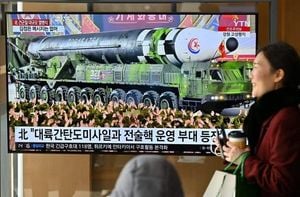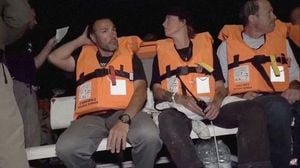On Friday, September 5, 2025, the usually quiet expanse of the Secret Service training complex in Maryland transformed into a scene straight out of a tense political thriller. Sirens blared, riot shields glinted in the sun, and the air crackled with urgency as 600 officers from nearly 20 law enforcement agencies—including the Secret Service, U.S. Capitol Police, and local police and sheriff’s departments—gathered for one of the largest law enforcement training drills in the country. The goal? To ensure that the security failures of the January 6, 2021, Capitol attack are never repeated.
The scale of the operation was striking. As reported by the Associated Press, the drill was meticulously designed to address the kinds of security breakdowns that left lawmakers and law enforcement vulnerable during the infamous siege on the Capitol. Officers in full riot gear practiced coordinated responses to a series of high-stakes, simulated emergencies. In one scenario, a lawmaker was trapped inside a car as protesters pounded on the windows, boxing the official in. Within seconds, a tactical team surged forward, yanked open the doors, and pulled the passenger to safety. Elsewhere, another team spotted a man in the crowd with a gun, isolated him, and made a swift arrest. Every move was choreographed with precision, but the tension was real—because the threats these officers are preparing for are no longer hypothetical.
According to Business Standard, the urgency behind this unprecedented drill is not just a reaction to the past. With 2025 already on track to bring more threats against members of Congress than any year in history, law enforcement agencies are bracing for a volatile era. Surging political violence, swelling protest movements, and a more muscular federal presence in local communities are the new reality. The line between routine dissent and potential disaster, as the report notes, feels "increasingly thin" in today’s America.
Michael Sullivan, chief of the U.S. Capitol Police, underscored the gravity of the situation: "Training like this is incredibly important. Making sure that we understand how the different teams work is critically important if we ever have to make that call for them to come in and help." Sullivan’s words reflect a force still deeply marked by the events of January 6, when hundreds of officers were injured and the nation watched as the seat of American democracy was stormed.
Sean Gallagher, an assistant chief who has overseen the department’s response to scathing inspector general and congressional reports, emphasized that the agency is not ignoring past failures. "This is our attempt at fixing those issues," Gallagher said. "We’re facing a lot of different threats. It’s a heightened political environment that we continuously operate in on Capitol Hill. We’ve taken the lessons of the past, we’ve incorporated them into these scenarios and the goal with this is to be proactive and not reactive."
That proactive mindset is now embedded at every level. Aaron Davis, a Capitol Police officer who has spent nearly eight years on the civil disturbance unit and responded to the January 6 attack, explained why these drills are essential: "We use our imagination like crazy in training, just because you don’t want that to be the first time you encounter something of that nature." For Davis and his colleagues, no scenario feels implausible anymore.
The realism of the drills was intentional, and at times, unsettling. Demonstrators—played by fellow officers—shouted "Free DC" as they hurled wooden blocks meant to simulate bricks, echoing the anger that has erupted in American cities over the deployment of federal agents and National Guard troops. "Keep moving, back up!" officers shouted as they marched the crowd down the street behind riot shields. An unmarked police van whisked away those taken off in handcuffs. The message was clear: law enforcement is preparing for the volatile mix of protest and confrontation that has become all too common.
One of the most significant changes since January 6 has been the shift from isolated agency training to joint drills. According to Business Standard, agencies that once operated largely in silos now train side by side, building the muscle memory needed for rapid, coordinated deployments. This shift is not just about tactics—it’s about communication. The drill showcased new tools, including drones that provided real-time aerial views of the mock protests and mobile command posts that allowed leaders from different agencies to track events simultaneously and direct units on the ground. These innovations are designed to prevent the kinds of communication breakdowns that hobbled the response on January 6.
Andrew Ackley, assistant chief of the Secret Service’s Uniform Division, spoke about how the agency’s tactics have evolved in response to recent events. Reflecting on the mass demonstrations that filled Washington in 2020 during the first Trump administration, Ackley said, "The training has evolved significantly because we’re constantly learning. None of these situations are identical, right? None of these situations can be copycat from another one. So we’re constantly evolving. We’re constantly training."
The stakes could hardly be higher. As threats against public officials continue to mount, federal authorities are stepping more aggressively into cities to confront unrest. From the storming of the Capitol to more recent attacks targeting lawmakers and judges, the scenarios practiced in Friday’s drill resonate deeply. The exercises were not just about riot shields and tactical maneuvers—they were about preparing for a future where the next flashpoint could erupt at any moment.
The lessons of the past are shaping the present. The January 6 attack exposed vulnerabilities not just in physical security, but in coordination and communication between agencies. Inspector general and congressional reports in the aftermath of the attack highlighted critical failures, from delayed calls for backup to confusion over who was in charge. The joint training exercises in Maryland are a direct response to those findings, an effort to ensure that the mistakes of the past do not become tragedies of the future.
Beyond the drills themselves, the event symbolizes a broader shift in American law enforcement. As protest movements grow and political rhetoric heats up, officers on the front lines are being asked to do more than ever before. They must balance the right to dissent with the need to maintain order, all while facing unprecedented threats. The presence of federal agents and National Guard troops in recent years has only heightened tensions, making coordination and clear communication even more essential.
For the officers who participated in Friday’s drill, the experience was both sobering and empowering. The scenarios they practiced may have been staged, but the dangers they represent are all too real. As Sullivan, Gallagher, Davis, and Ackley all made clear, the goal is not just to respond to the next crisis, but to anticipate it—and, if possible, prevent it altogether.
As the sun set over the Maryland training complex, the officers packed up their gear, debriefed, and prepared to return to their posts. The lessons learned on that field will echo through the halls of Congress, the streets of Washington, and the command centers of agencies across the country. In a nation where the line between protest and peril grows ever thinner, those lessons could make all the difference.





